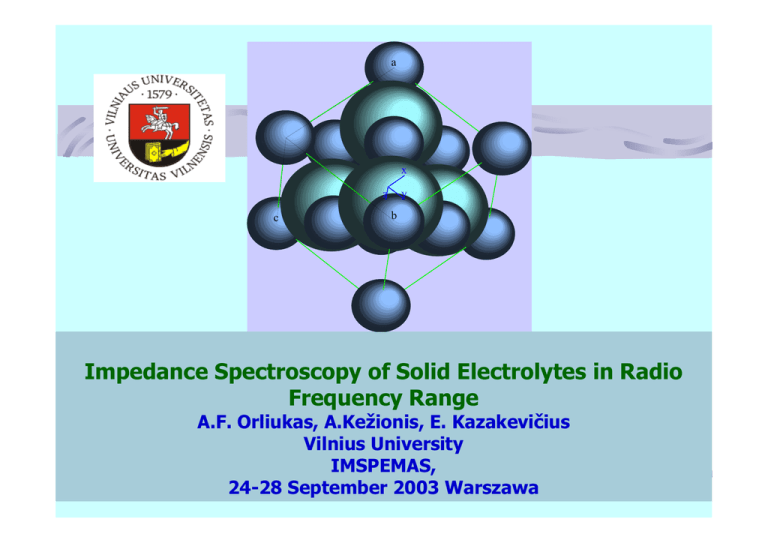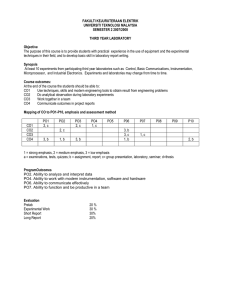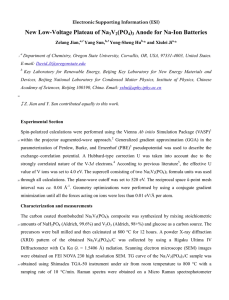Impedance Spectroscopy of Solid Electrolytes in Radio Frequency
advertisement

a x y z c b Impedance Spectroscopy of Solid Electrolytes in Radio Frequency Range A.F. Orliukas, A.Kežionis, E. Kazakevičius Vilnius University IMSPEMAS, 24-28 September 2003 Warszawa Outline of the report 1. Block diagram of computer controlled complex impedance measuring system in the frequency range 1 MHz – 1.2 GHz 2. Typical results of the measurements of complex impedance, complex conductivity and complex dielectric permittivity of solid electrolyte ceramics 3. Conclusions Sample Al2O3rods Refractory alloy tube Pt layer Thermocouple Scheme of experimental device of impedance measurements (sample holder ) Frequency Response Analyzer Computer Transmitted wave Coaxial wave guide Sample Heater Temperature control unit Scheme of experimental device of impedance measurements (measurement system) ~ Z = Z ′ + iZ ′′ σ~ = σ ′ + iσ ′′ ε~ = ε ′ − iε ′′ ~ M = 1 / ε~ The outputs Ui and Ut of couplers A1 and A2 respectively may be expressed by the transmittance coefficients for incident and reflected waves k1 and k2 in the exit Ui and by the corresponding coefficients k3 and k4 in the exit Ut: iβl − iβl U i = k1e a1 + k1e b1 , iβl −iβl = + U k e b k e a t 3 2 4 2 1 1 21 2 (1) here β is a propagation constant in the coaxial line. By introducing “measurement” transmission coefficient T = U / U and “real transmission coefficient Tr = b2 / a1 one can show that m t i Tr = d 0 + d1Γin ' Tm (2) where d0 and d1 are combinations of coefficients ki and exponential propagation parts of wave functions in the line; Γin is reflection coefficient in the plane 2-2. If we assume the symmetrical quadruple its sparameters are equal in pairs: S11=S22 and S12=S21. According to theory of quadruple: 1 Tr = S 21 1 − S11ΓL' (3) S 212 ΓL' Γin = S11 + 1 − S11ΓL' (4) and where Γ’L is reflection coefficient of a load in the plane 3-3. Substituting Eqs. (3) and (4) into Eq. (2), 1 S11 S 212 − S112 + b2 + b3 Tm = b1 + S 21 S 21 S 21 where b1, b2 and b3 are linear combinations of d0, d1 and Γ’L. (5) For symmetrical Π-type quadruple we have : S 21 = 2 2(1 + Z1−1 ) + (1 + Z ) −1 2 (6) 1 Zx 2 Zx − 2 Z1 Z1 , S11 = −1 2 ( ) 1 + Z1 2(1 + Z1−1 ) + Zx Zx − (7) where Zx and Z1 are elements of the impedance of the symmetrical quadruple. In the limit case, then Z1 → ∞, Eq. (5) becomes 1 = d2 + d3Z x , Tm with d2, d3 being combinations of b1, b2 and b3 (8) In absence of a sample, then the central line is shorted, Zx=0 and Tm we denoted as T0. Then d2=1/T0 and from Eq. (8) 1 1 = = Z x d3. Tm T0 (9) The complex impedance of Zx element of the quadruple may be expressed by the complex capacitance of the central line gap filled a sample as 1 = iω (Cs − C0 s + C0 ) Zx (10) where Cs is capacitance of a sample , C0s is the geometrical capacitance of a sample with dielectric permittivity ε=1, i.e. C0s=ε0S/d, C0 is a capacitance of the gap of length d in the central line in absence of sample. From Eqs. (9) and (10) 1 1 d3 . = = Tm T0 iω (Cs − C0 s + C0 ) (11) We have three unknown parameters, d3, C0 and Cs, so three measurements must be done to find them. We used the same length d of the gap for calibration (to establish d3 and C0) and for measurement. The complex capacitance of the sample may be obtained by solving the system of equations: 1 1 d3 = = T T iω (C − C + C ) 0 1 01 0 1 1 1 d3 , = = ( ) ω T T i C − C + C 0 2 02 0 2 1 1 d3 = = Tx T0 iω (Cs − C0 s + C0 ) (12) where T1 and T2 are the transmittance coefficients for circuit with the calibration samples of capacitance C1 and C2, Tx is transmittance coefficient in system with the sample under investigated, C01, C02 and C0s are geometrical capacitance of the samples. The impedance of the measured sample Z s = Z '−iZ " = 1 1 , = iωCs iω ( A2 (C1 − C01 + C0 )) + C0 s − C0 (13) where C0 = A1 (C1 − C01 ) + C02 − C2 . 1 − A1 Parameters A1 and A2 are equal to T0 −1 T , A1 = 1 T0 −1 T2 T0 −1 T A2 = 1 . T0 −1 Tx (14) The calibration of the system was performed by three measurements of the transmission coefficients of line, one shorted and others two loaded with different samples of known capacitance and very low dielectric losses. The substitution of M3+ and M2+ ions in LiTi2(PO4)3 solid electrolytes The substitution Ti4+ M3++Li+ realize in the compounds Li 1+x M xTi2-x(PO4)3 (where M=Sc, Al, Fe, Y; x=0.3) The substitution Ti4+ M3++Li+ realize in the compounds Li 1+x+y M x (M y )Ti2-x-y(PO4)3 (where M=Sc, B; x=0-0.3, y=0-0.3) The substitution Ti4+ M2++2Li+ realize in the compounds Li 1+2x M xTi2-x(PO4)3 (where M=Mg; x=0.3) The compounds at room temperature belongs to the rhombohedral v symmetry (s. g. R3c), Z=6 B Frequency dependences of Re(σ) of Li1.6Mg0.3Ti1.7(PO4)3 ceramics at different temperatures. Re(σ), S/m -2 10 T=360K T=330K T=310K -3 10 T=300K 1 10 2 10 3 10 4 5 10 10 f,Hz 6 10 7 10 50 300K Z",Ω m 40 30 20 10 0 0 10 20 30 Z',Ω m 40 50 Complex plane impedance plots of Li1.3Y0.3Ti1.7(PO4)3 ceramic sample at temperature T=300K 10 455K Z",Ω m 8 6 4 2 0 0 2 4 6 8 10 Complex plane impedance plots of Li1.3Y0.3Ti1.7(PO4)3 ceramic sample at temperature T=455K 575K Z ",Ω m 3 2 1 0 0 1 2 3 Complex plane impedance plots of Li1.3Y0.3Ti1.7(PO4)3 ceramic sample at temperature T=575K Z", Ω m 2 10 300 K 1 10 0 10 400 K 500 K -1 10 600 K 6 10 7 8 10 10 9 10 f,Hz Frequency dependence’s of Z′′ of Li1.5Ge1.5Al0.5(PO4)3 (●) and Li1.3Ge1.7Cr0.3(PO4)3 (○) compounds at different temperatures σtotT, KS/m 10 2 10 1 10 0 1,6 Sc, ∆E tot =0.42eV Al, ∆E tot =0.33eV Fe, ∆E tot =0.40eV Y, ∆E tot =0.30eV 2,0 2,4 1000/T,K -1 2,8 3,2 Temperature dependences of σtot of Li1+xMxTi2-x(PO4)3 solid electrolyte ceramics (where M= Sc, Al, Fe, Y; x=0.3) 3 10 Al, Fe σbT, S⋅K/m 0.31eV 0.30eV 2 10 Y 0.19eV Sc, 0.2eV 1 10 2.0 2.4 2.8 3.2 -1 1000/T,K Temperature dependences of σb of Li1+xMxTi2-x(PO4)3 solid electrolyte ceramics (where M=Sc, Al, Fe, Y; x=0.3) t σ ,S /m 10 0 10 -1 10 -2 1,8 2,1 2,4 1000/T ,K 2,7 -1 ■ Li1.3Sc0.3Ti1.7(PO4)3 ■Li1.3Sc0.2B0.1Ti1.7(PO4)3 ■ Li1.3Sc0.1B0.2Ti1.7(PO4)3 ■Li1.3B0.3Ti1.7(PO4)3 3,0 σb,S/m 0 10 -1 10 2.1 2.4 2.7 1000/T,K 3.0 -1 ■ Li1.3Sc0.3Ti1.7(PO4)3 ■Li1.3Sc0.2B0.1Ti1.7(PO4)3 ■ Li1.3Sc0.1B0.2Ti1.7(PO4)3 ■Li1.3B0.3Ti1.7(PO4)3 3.3 0,5 0,4 0,08 0,3 0,06 0,2 0,04 0,02 0,1 0,0 0,1 0,2 y Li1+x+yScxByTi2-x-y(PO4)3 0,3 0,0 ∆ E,eV σ b 300K,S/m 0,10 10 9 f b ,H z 10 8 10 7 2 ,2 A l, ∆ E f = 0 .3 0 e V F e , ∆ E f = 0 .3 0 e V Y , ∆ E f = 0 .1 9 e V S c , ∆ E f = 0 .1 9 e V 2 ,4 2 ,6 2 ,8 1 0 0 0 /T ,K 3 ,0 -1 3 ,2 3 ,4 Temperature dependences of relaxation frequency σb of Li1+xMxTi2-x(PO4)3 (where M= Sc, Al, Fe, Y; x=0.3) ceramics 9 10 8 10 7 fb,Hz 10 2,4 2,7 3,0 -1 1000/T, K ■ Li1.3Sc0.3Ti1.7(PO4)3 ■ Li1.3Sc0.1B0.2Ti1.7(PO4)3 3,3 ■Li1.3Sc0.2B0.1Ti1.7(PO4)3 ■Li1.3B0.3Ti1.7(PO4)3 20 ε' 15 10 5 300 350 400 T,K ■ Li1.3Sc0.3Ti1.7(PO4)3 ■Li1.3Sc0.2B0.1Ti1.7(PO4)3 ■ Li1.3Sc0.1B0.2Ti1.7(PO4)3 ■ Li1.3B0.3Ti1.7(PO4)3 450 Conclusions The impedance spectroscopy method based on the transmission coefficient measurement in a coaxial waveguide is using for investigation of solid electrolyte materials in the frequency range from 1 MHz to 1.25 GHz in the temperature interval from 300 K to 1200 K. The substitution Ti 4+ → σ, fb and ε of the compounds. M 3+ + Li + (where M=Sc, Al, Fe, Y, B) and Ti 4+ → Mg 2+ + 2 Li + in LiTi2 (PO4 )3 effects on Two regions of the impedance dispersion are analyzed in terms of the fast Li+ ion transport in the bulk and grain boundaries of the ceramic samples. The temperature dependence’s of the bulk conductivity and relaxation frequency in the bulk are governed by the same activation energy. That suggests that charge transport in the investigated compounds may be described mainly by the temperature dependent ion mobility, while concentration of mobile Li+ ions is independent on temperature. The values of ε′ of the both materials at room temperature and at the frequency of 1.2 GHz are related mainly to the contribution of the polarization due to migration of Li+ ions, lattice vibrations and electronic polarization.




